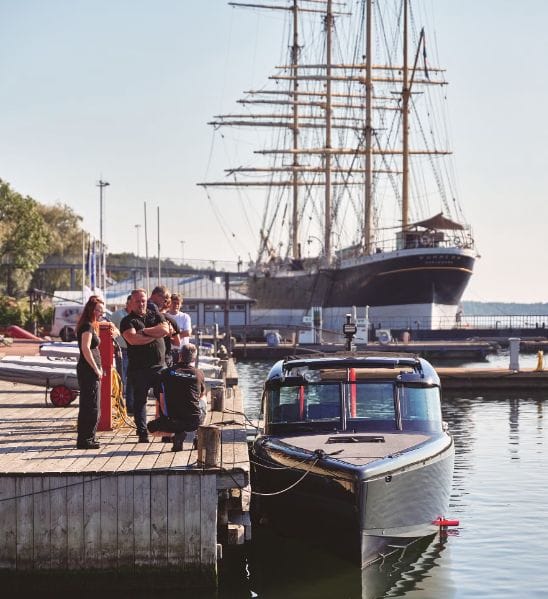
Baltic Sea conquered by Candela’s electric C-8: no range anxiety

Citing 95 per cent lower costs than a fossil-fuel-powered boat, a team has crossed between Stockholm and the Finnish autonomous region of Åland twice in one day. A group of Swedes drove a hydrofoiling Candela C-8 there and back (150 nautical miles) across the Baltic Sea, further bolstering Candela’s reputation for pushing boundaries. This comes prior to the company launching its new hydrofoil ferry in Stockholm – which is bound to be keenly watched by cities across the world who are looking to embrace an environmentally cleaner way of managing their waterways.
“We actually had range anxiety, but not for the Candela,” says Gustav Hasselskog, CEO and founder of Candela, speaking of the Baltic journey. “The irony is that the photographer’s gasoline-powered chase boat had to refuel six times during the trip, while we only charged three times.”
The C-8 which made the trip used a Polestar battery. After a charging stop in Kapellskär, it reached Mariehamn at lunchtime, making it the first electric boat to cross the Baltic Sea between Sweden and Finland.

“The aim was to demonstrate that zero-emission sea travel is not only possible today, but that foiling electric ships and boats are so much cheaper to operate than fossil-fueled vessels,” says Hasselskog.
“The disadvantage of electric boats has been their short range, due to traditional boat hulls consuming so much energy. With our hydrofoil technology, we combine high speed and range, but you get so many other benefits. Flying over the Åland Sea in total silence and without slamming was absolutely magical.”
The trip was made mostly with the existing charging infrastructure, and in partnership with Kempower, a charging solutions provider. In Kapellskär, the Candela charged with a Kempower Movable Charger, a 40kW wheeled charger, connected to the existing power grid at the harbour. In Finland’s Mariehamn, the boat was plugged into the marina’s three-phase outlet.
The gasoline-powered chase boat of similar size that accompanied the trip had to refuel for 750€ during the 150 nautical miles – while the Candela C-8 consumed 213kWh of electricity, at a cost of about 40-50€.
“We’re talking about 95 per cent lower operating costs. This is a revolution that makes waterborne transport competitive with land transport in terms of costs, which we will now demonstrate in public transport in Stockholm,” says Hasselskog. He’s referring to the Candela P-12, the company’s new 30-passenger hydrofoil ferry, will begin operating the Ekerö-Stockholm City Hall route. It is expected to halve travel times thanks to not producing damaging wakes, allowing it permission to travel quickly in the inner city later this year.
“We can easily electrify coastal public transport at very low costs, not just in Sweden but across the world. It just requires political will to make the switch,” concludes Hasselskog.

Recently the Stockholm-based company signed a deal to supply eight P-12 vessels to NEOM, a global development project in northwest Saudi Arabia. This marks the largest order in Candela’s history; deliveries are scheduled for early 2025 and 2026.
The post Baltic Sea conquered by Candela’s electric C-8: no range anxiety appeared first on Marine Industry News.
